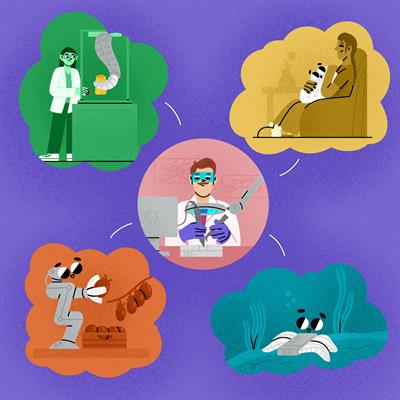
Soft Robotics
Collection Editors
Jonathan Rossiter, Laura Blumenschein, Markus NemitzViews
30,626 viewsParticipating Sections
Submission Deadline
Closed
Articles

Engineering and Technology
03/02/2025
Softer, Safer, Smarter: Robotic Hands Inspired by...
Authors
Silvia Terrile, Loong Yi Lee
Engineering and Technology
17/01/2025
Exoskeletons: Enhancing the Future of Physical...
Authors
Žiga Kozinc, Karl E. Zelik
Engineering and Technology
13/11/2024
Robots that Can Survive the Egg Drop
Authors
William R. Johnson III, Rebecca Kramer-Bottiglio
Engineering and Technology
29/08/2024
Soft Robotics: If You Can Dream It, Can You Print...
Authors
John Garrett Williamson, Caroline Schell, Michael Keller...
Engineering and Technology
09/08/2024
Can Hugging a Soft Robotic Cushion Help When You...
Authors
Alice Haynes, Jessica L. Fielding, Annie Lywood...
Engineering and Technology
24/07/2024
Why Robots Should Grow Like Vines
Authors
Ciera McFarland, Francesco Fuentes, Allison Fick, Laura H...
Engineering and Technology
11/06/2024
Jellyphant: A Soft, Elephant Trunk-Inspired...
Authors
Lois Liow, David HowardAbout this collection
Take a look around: you may be surprised by how many of the things you see were created with the help of robots. Perhaps robots made your clothes or the furniture in your room, or your computer or phone. Robots may have even helped to grow the food you ate for breakfast. In the future, robots will be even more common. One day, not only will many more things be made by robots, but some things could actually be robots themselves! To reach this future, we must start thinking about robots in new and different ways.Soft robotics is one of these new ways of thinking—this field deals with the use of soft materials to make robots. Today, most robots are made from rigid materials, like plastics and metals, but we could make completely new types of robots using softer materials. There are many reasons we might want to do this. For instance, most living things are quite soft, so using soft materials would allow the creation of robots that act more like animals or plants. Robots made from soft materials would also be a lot safer when interacting with living things, including humans and the natural environment.
This Collection will examine a few of the countless places and ways that softer robots could be used. There are many questions to consider when designing new robots. Just because robots are soft doesn't mean they are always safe, so it will be important to ensure that soft robots are friendly and that they do what the designers want them to do. It is also necessary to consider what will happen to soft robots when they are no longer needed, or when they break. If these robots become common, how can we make sure that they will not pollute the environment?
This Collection will showcase some of the ways robotics scientists and engineers are trying to answer these questions. The aim of the Collection will be to provide you, our readers, with a broad view of what future robots could look like and what they could do, through the lens of soft robotics.
In addition to the Editors hosting, we would acknowledge the coordination and organization efforts of Daniel Gosden.
Would you like to submit to this collection?
For researchers interested in submitting to this Collection, please consult our author guidelines and check that you have all the essentials included before submitting













